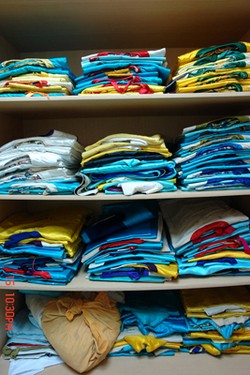
Big wardrobe putting costumes
The attraction of Chinese opera is the variety of colorful and beautiful costumes. The costume was designed by artists and embroidery craftsmen in generations, and reformed by the outstanding actors. Also known as “Hang-Tou,” the Chinese opera costumes have no distinction of dynasty, areas, and seasons. In the opera, no matter how important the role is, there are rules for wearing what kind of clothes. Following is the introduction of the clothes and accessories for the actors in the opera:
■Functions of the Colors
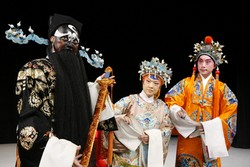
Only the empire and royal people can wear yellow Mang Pao.
In early Chinese opera, there were only red, yellow, white, black and green colors for the clothes. Later, due to the items of opera and the characters increased, colors are not enough in use. There were five colors added—purple, pink, blue, bonze, and bluish. For the former five colors are used mostly in formal occasions and for high-ranking officials and generals; as to the latter five colors are used normally for casual clothes and civilians. Therefore, it is districted by “upper five colors” and “lower five colors.” Definitely, along the accumulation of opera titles and the innovation of operas, colors of clothes are diversified, more than the norm of the ten basic tones. Mang Pao (the python-patterned long gown) represents the strictest color norm for identity. Only empire and royal people can wear yellow Mang Pao, red Mang was for middle ranking officials, and white Mang Pao for elderly and ternder senior officials.
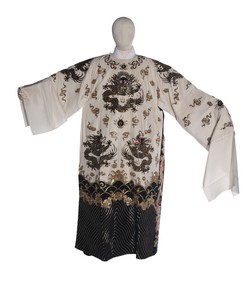
White mang pao
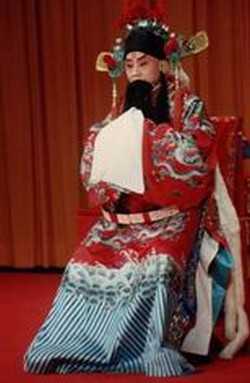
Red Mang Pao
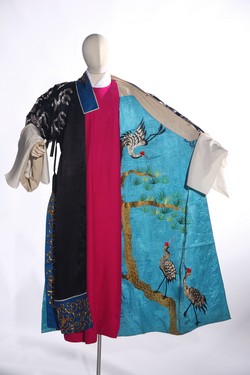
Home dress of military general
■Representation of the Decoration Patterns
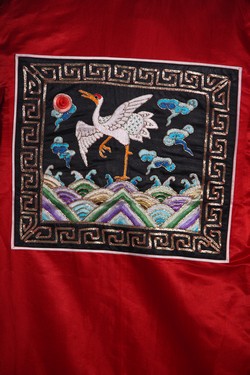
There are various patterns from the costumes
The Chinese costume is primarily with “dragon” and “Feng” (phoenix) embroider patterns. There are still flora, butterfly, birds and animals, used in different character costume. For example, “dragon” and “Feng” embroider patterns can only be used for the ruling class such as empire or high officials related characters. Although mang pao has dragon patterns embroidered; however, there is only empire that can embroider five-claw dragon patterns, the other officials can only embroider four-claw dragon to make the distinction. And the “bu ze” patterns of the official gown also adopted with the ancient official gown—for those civil officials with birds, and military animal.
■Types of the Clothes
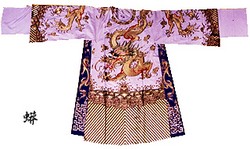
generally called “dragon gown”
Mang:Ordinary audience calls it “dragon gown”. In the Chinese opera, most empire, high ranking officials, and queen and princess consort wear such clothes. The style of Mang is like round collar, big front opening, open cross beneath the shoulder, and with different color wide edge strip calledbai; Under both front and back chest, there are sea water wave teeth patterns embroidered. Male mang will be embroidered surrounded by circle dragon or flying dragon; female mang embroiders phoenix flying toward the Sun, and with long skirt and long soft strip accessories.
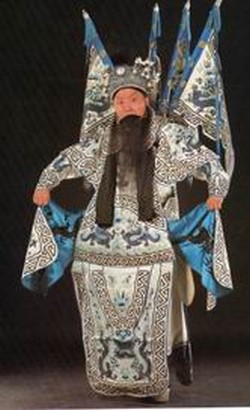
When a military general goes to the war, wearing all hangings and ties upper Kao
Kao:Such dress is designed by copying the war robe of ancient generals and soldiers. The military generals tied upper “kao” to represent military spirit and high-end heroic ambience. Kaos are divided into two kinds: male and female. Male kao is divided into two pieces in the front and back of the body, with plain silk to have fish fins patterns embroidered on them. Close to the belly, it looks like a tiger head. Two shoulders are made like butterfly or tiger head shape, with long sleeves tightened in the wrests. On the neck, there is cloud shape collar. Along the two sides of legs, there are kau pai ze, on the back, there is leather bag to hang kao flags, called “back tiger”.
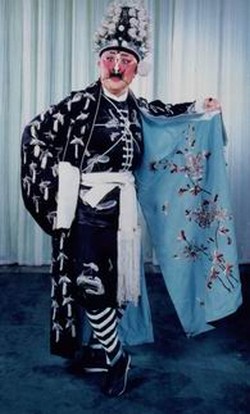
With more patterns means more affluent.
Zhe:In the Chinese opera costumes, it belongs to casual dress. It is used most frequent. No matter which occupation or identity, character normally wears such dress. For tan, the zhe is like paraller collar, shorter. If the zhe with embroidery of flying birds, butterfly, and flowers, it is called flora zhe, and for the zhe without embroidered called plain zhe.
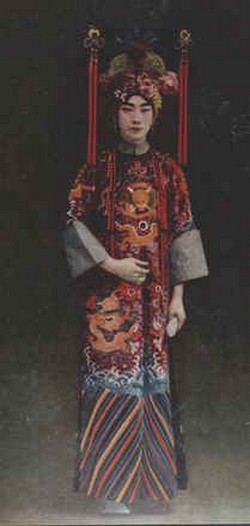
Qi Man
Qi Mang:Pagan princess wears qi mang when goes to the empire palace to meet the empire.
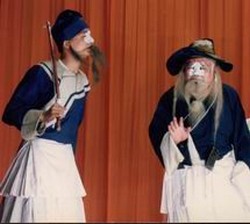
civilian’s clothes
Clothes:In the Chinese opera, I (clothes) have most various kinds. Dresses of princess, officials, soldiers, servants, civilians and heroes are all called I. For the upper level people, besides mang, zhe, Pi, there are also official clothes, Eunuch clothes, royal clothes, and arrow clothes and so on. Royal clothes were worn by princess, and princess of empire’s relatives. The lower level characters also have special cloth styles. Except soldiers and executioner they have designated clothes, fisherman and boy attendant wear parallel collar rough cloth and pants. Lovely young girls wear embroidered short cotton jacket and pants that showed beautiful and colorful. And monks wear Ba-Gua clothes, nun’s clothes and Buddhist clothes; and fairies have their own dressings.
■ Accessories of the Clothes
Helmet:In the Chinese opera, people wear “helmet” and “cap”. In general, it is called “kui tou.” There are kui, hat, jin (towel), and guan (royal hat). “Kui” is copied the helmet style of ancient warriors and exaggerated and beautified. For those who wear helmets are all major high-ranking officials, with military and solemn inclination. The empire normally wears guan with 9 dragons; and the queen, princess and princess of king’s relatives and other royal women may wear phoenix guan. Jin is the normal hat worn casually, usually there is square jin and Uan-uai jin.
Kan-Jian:It is a sleeve-less clothes. Female wearing such vast style clothes in the opera represents a servant role. If the kan-jian is colorful, that means it is the nun’s vast, a person who left secular world.
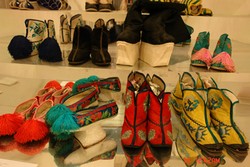
Boots and shoes put by the actors.
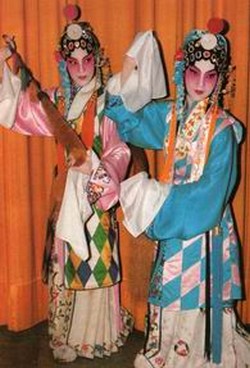
Kan-jian for female wearing
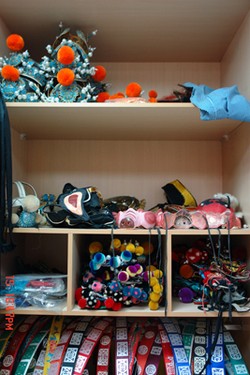
Helmet wardrobe for actors
Boots and shoes:The thick heeled boots are thick for some 3-4 inches, normally matched with mang kao and other accessories. It makes the role grandeurs and tall and handsome. The thin bottom of boots also called fast boots, worn by military female and male roles, easy to do the martial fighting. Fu ze shoes also called happiness shoes, normally worn by eldly men and ladies. Colorful shoes normally worn by ordinary female; it has a round decoration on the shoe top. Qi shoes also called vase bottom with tiptoe and foot heel in the air. Qiao is made by cloth wrapping on the wood, primarily to satisfied the 3-inch small feet of ancient ladies.
Reference:
National Taiwan College of Performing Arts http://content.ndap.org.tw/index/?p=736 /sorted by the research team
Source of the Photos:
National Taiwan College of Performing Arts http://content.ndap.org.tw/index/?p=736
Guoguang Opera Company http://www.kk.gov.tw/
Teaching website of JingJuLong http://www.jingjulong.cn/intro_to_beijing_opera.htm
